-
Countries
-
Data and Analysis
-
Special Focus
-
Crisis Responses
Apr 26 2024
Print
On 15 April 2023, armed clashes erupted between the Sudanese Armed Forces (SAF) and the Rapid Support Forces (RSF) in multiple cities across Sudan. Clashes initially took place in cities across Northern and Khartoum states, later spreading across the Darfur and Kordofan regions.
Countries in this response
- Active DTM operation
- Past DTM operation

Contact
DTM Nigeria, AllUsersInDTMNigeria@iom.int
Language
English
Location
Nigeria
Period Covered
Apr 15 2024
Apr 17 2024
Activity
- Mobility Tracking
- Event Tracking
On 15 and 17 April 2024, fires broke out in Malayi camp and Lawanti host community in Gaji Ganna I ward of Magumeri Local Government Area (LGA) and in Ngurno and Water Board camps in Monguno ward of Monguno LGA, all in Borno State. The fires damaged and destroyed shelters and belongings of numerous displaced households. There were no reports of fatalities and injuries. The fires impacted 88 emergency shelters, affecting 513 individuals in 88 households. The affected individuals included 361 children, 81 women and 71 men.
Of all the needs identified, shelter, food and non-food items (NFI) were the most prevalent. Other needs included water, sanitation and hygiene (WASH) and health.
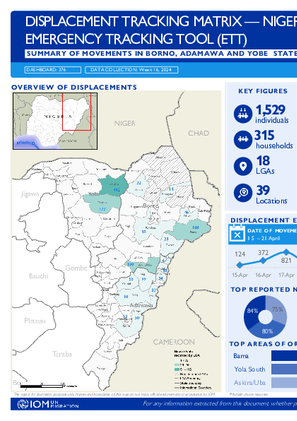
Contact
DTM Nigeria, iomnigeriadtm@iom.int
Language
English
Location
Nigeria
Period Covered
Apr 15 2024
Apr 21 2024
Activity
- Mobility Tracking
- Event Tracking
Between 15 and 21 April 2024, a total of 1,529 new arrivals were recorded at locations in Adamawa, Borno and Yobe states. The new arrivals were recorded at locations in Askira/Uba, Bama, Dikwa, Gubio, Gwoza, Konduga and Monguno Local Government Areas (LGAs) of the most conflict-affected Borno State, in Fufore, Gombi, Hong, Madagali, Maiha, Michika, Mubi North, Song and Yola North LGAs of Adamawa State and in Geidam and Tarmuwa LGAs of Yobe State.
ETT assessments identified the following movement triggers: fear of attack (500 individuals or 33%), poor living conditions (409 individuals or 27%), family re-unification (238 individuals or 15%), improved security (163 individuals or 11%), seasonal farming (113 individuals or 7%) and military operations (106 individuals or 7%).
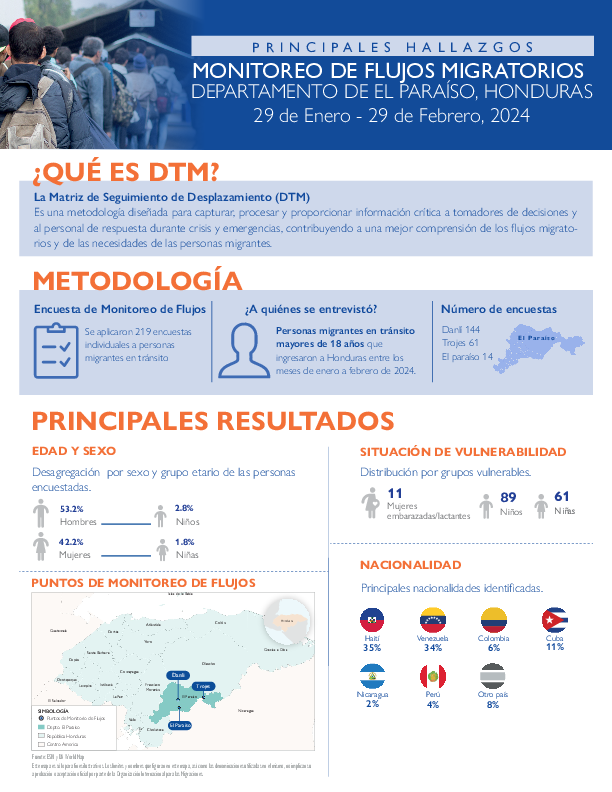
Contact
iomtegucigalpa@iom.int
Language
Spanish
Location
Honduras
Period Covered
Jan 29 2024
Feb 29 2024
Activity
- Survey
- Flow Monitoring Survey
- Flow Monitoring
Se aplicaron 219 encuestas individuales a personas migrantes en tránsito en el departamento de el Paraíso, Honduras.
- Las principales nacionales identificadas fueron de Haití (35%), Venezuela (34%), y Cuba (11%).
- 53% de los entrevistados eran Hombres, 42% mujeres, 3% niños y 2% niñas.
- Las principales necesidades mencionads fueron: Asistencia de transporte (89%), alimentación (73%), y asistencia de documentos (35%).

Contact
DTM Niger, NigerDataResearch@iom.int
Language
French
Location
Niger
Period Covered
Jan 01 2023
Dec 31 2023
Activity
- Survey
- Flow Monitoring Survey
- Flow Monitoring
- Migrants presence
- Mobility Tracking
La mobilité humaine à destination, ou à travers le Niger constitue un phénomène aux multiples dimensions et variétés. Elle comprend la transhumance, les migrations saisonnières liées à la période des récoltes, les voyages durant les fêtes religieuses, le tourisme, la migration économique vers le nord et l'ouest de l'Afrique, la recherche d'emploi, les déplacements imposés par les conflits, les catastrophes naturelles ou les effets du changement climatique, ainsi que l'exode rural. Ces éléments illustrent la diversité de la mobilité observée au Niger et dans la région de l'Afrique de l'Ouest et du Centre.
Ce rapport, élaboré à partir de données collectées de sources primaires et secondaires, vise à tracer un portrait des tendances et dynamiques migratoires du Niger, pour mieux saisir leur complexité et examiner les interactions entre les différents types de mouvements à travers le pays.
Bien que non exhaustif, ce document cherche à donner une vue d'ensemble sur la mobilité au Niger, tout en esquissant les profils des individus qui participent à ces mouvements.
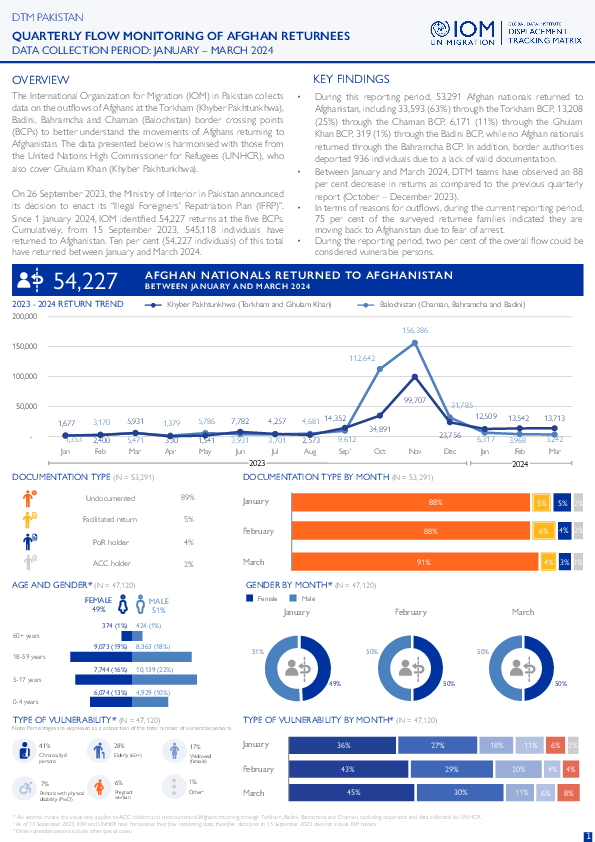
Contact
DTMPakistan@iom.int
Language
English
Location
Pakistan
Period Covered
Jan 01 2024
Mar 31 2024
Activity
- Flow Monitoring
The International Organization for Migration (IOM) in Pakistan collects data on the outflows of Afghans at the Torkham (Khyber Pakhtunkhwa), Badini, Bahramcha and Chaman (Balochistan) border crossing points (BCPs) to better understand the movements of Afghans returning to Afghanistan. The data presented below is harmonised with those from the United Nations High Commissioner for Refugees (UNHCR), who also cover Ghulam Khan (Khyber Pakhtunkhwa).
On 26 September 2023, the Ministry of Interior in Pakistan announced its decision to enact its “Illegal Foreigners’ Repatriation Plan (IFRP)”. Since 1 January 2024, IOM identified 54,227 returns at the five BCPs. Cumulatively, from 15 September 2023, 545,118 individuals have returned to Afghanistan. Ten per cent (54,227 individuals) of this total have returned between January and March 2024.
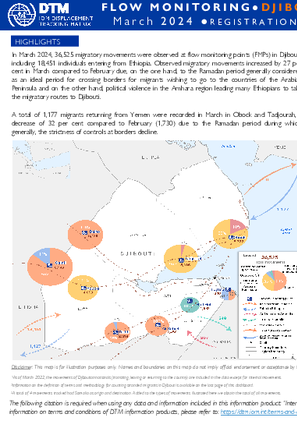
Contact
DTM Djibouti, DTMDjibouti@iom.int
Language
English
Location
Djibouti
Period Covered
Mar 01 2024
Mar 31 2024
Activity
- Flow Monitoring
In March 2024, 36,525 migratory movements were observed at flow monitoring points (FMPs) in Djibouti, including 18,451 individuals entering from Ethiopia. Observed migratory movements increased by 27 per cent in March compared to February due, on the one hand, to the Ramadan period generally considered as an ideal period for crossing borders for migrants wishing to go to the countries of the Arabian Peninsula and on the other hand, political violence in the Amhara region leading many Ethiopians to take the migratory routes to Djibouti.
A total of 1,177 migrants returning from Yemen were recorded in March in Obock and Tadjourah, a decrease of 32 per cent compared to February (1,730) due to the Ramadan period during which, generally, the strictness of controls at borders decline
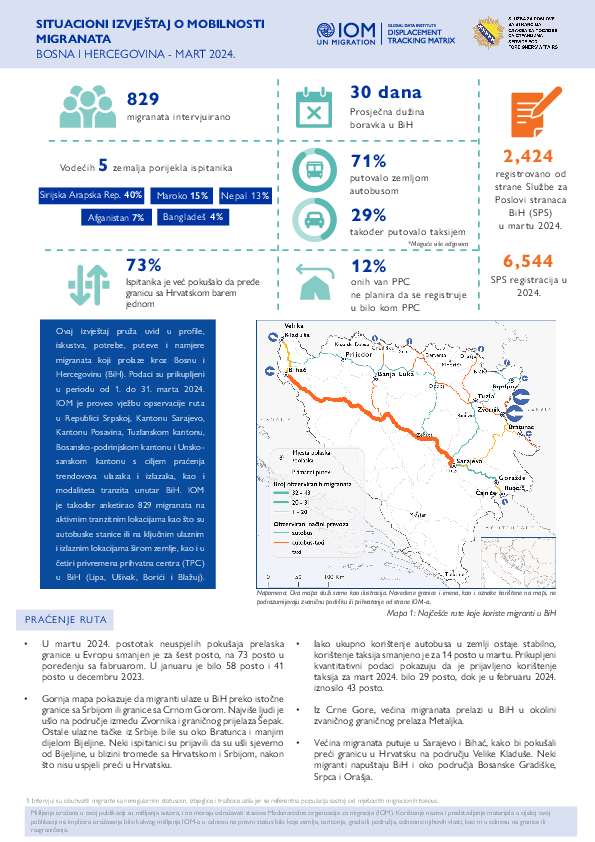
Contact
DTM Europe, DTMMediterranean@iom.int
Language
English
Location
Bosnia & Herzegovina
Period Covered
Mar 01 2024
Mar 31 2024
Activity
- Flow Monitoring
This report provides insight into the latest migration trends and patterns in Bosnia and Herzegovina (BiH). IOM surveyed 829 migrants from 1 March to 31 March 2024 in transit reception centres (TRCs) as well as in key entry, transit and exit locations around the country. The report provides insights into the profiles, experiences, needs, routes travelled and intentions of migrants transiting through BiH.

Contact
DTM Europe, DTMMediterranean@iom.int
Language
English
Location
Bosnia & Herzegovina
Period Covered
Mar 01 2023
Mar 31 2024
Activity
- Flow Monitoring
This report provides insight into the latest migration trends and patterns in Bosnia and Herzegovina (BiH). IOM surveyed 829 migrants from 1 March to 31 March 2024 in transit reception centres (TRCs) as well as in key entry, transit and exit locations around the country. The report provides insights into the profiles, experiences, needs, routes travelled and intentions of migrants transiting through BiH.

Contact
DTM Djibouti, DTMDjibouti@iom.int
Language
French
Location
Djibouti
Period Covered
Mar 01 2024
Mar 31 2024
Activity
- Flow Monitoring
En mars 2024, 36 525 mouvements migratoires ont été observés aux points de suivi des flux (FMP) à Djibouti dont 18 451 individus entrants en provenance d’Éthiopie. Les mouvements migratoires observés ont augmenté de 27 pour cent en mars par rapport à février dû, d’une part, à la période de Ramadan, généralement considérée comme une période idéale de franchissement des frontières pour les migrants désireux de se rendre vers les pays de la Péninsule Arabique, et d’autre part, des violences politiques dans la région d’Amhara, conduisant beaucoup d’Éthiopiens à emprunter les routes migratoires vers Djibouti.
Un total de 1 177 migrants de retour du Yémen a été enregistré en mars à Obock et Tadjourah soit une baisse de 32 pour cent par rapport à février (1 730) en raison de la période de Ramadan pendant laquelle, généralement, la rigueur des contrôles aux frontières baisse